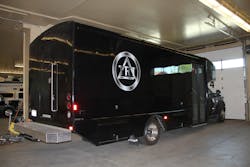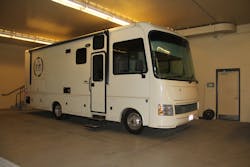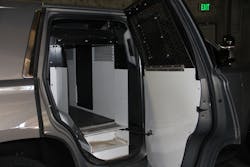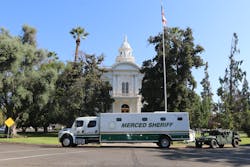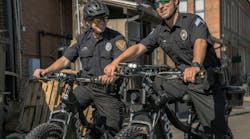As much as the law enforcement community can try, due to budget restrictions, logistics challenges and other reasons, it simply can’t find a “one size fits all” law enforcement patrol vehicle (LEPV). This article looks at three different types of specialized vehicles and some of the modifications that can go into them.
Vehicles for SWAT or Tact Team officers
Depending on the jurisdiction, the patrol vehicle assigned to a SWAT officer may be marked or unmarked. In most cases it doesn’t make much of a difference, but in those places where being on the SWAT team is a part time assignment, then it makes sense to have the vehicle fully marked. Whether the SWAT assignment is full or part time, there’s no question that the officer has to carry equipment that the average patrol officer doesn’t usually have. Virtually all of it, due to cost and potential liability attached (in the case of any weapons or munitions), has to be properly secured.
For that reason, most LEPVs assigned to SWAT officers are outfitted with extra lock boxes or secured storage drawers of some kind. The SWAT officer might be carrying (as assigned or simply to have available for the team) a precision rifle, munitions launcher, select fire weapon, breaching shotgun, and some less lethal weapons as well. He might also be carrying multiple pieces of expensive technology like night vision goggles, thermal sighting equipment and infrared optics. All of that is on top of the necessary higher threat level external body armor with equipment-carrying capability built in and a helmet.
That is a very basic list of equipment that might be needed in addition to anything the “average” patrol officer on the same agency carries. That requires additional storage or extra weapon locking systems. Many SWAT teams also carry rescue and/or climbing equipment—that has to be available as well. The “typical” SUV used as a LEPV has enough room but will require an alarm system and the properly mounted secured storage for all of that.
Vehicles for K-9 officers
It’s all too common for us to see stories in the news about children or pets left in vehicles that overheat and die. What do you do with your law enforcement canine partner when you’re going someplace you can’t take him? Most K-9 handlers know the answer but some agencies don’t want to institute it because of the cost. What do you do when you are assigned a canine partner, but the vehicle you’re assigned is designed and equipped for “average” patrol duties?
For the safety and protection of the canine officer, at a bare minimum, a carrier unit must be installed in the assigned vehicle. Typically, in a sedan, the carrier unit requires removal of the rear seat and is mounted in two or three parts. It is flat across the bottom and provides entrance/exit for the canine from the driver’s side rear door. Additionally, there’s usually a sliding portion (cage or window) between the front seats that, when open, allows the canine to stick his head out and lick the handler—or simply bark in his ear.In a SUV there is plenty of room in the back cargo compartment for the insertion of a carrier but then everything normally stored in that space has to be relocated. Back seats end up folded down (usually) and all that patrol equipment goes there.
No matter which you are using, there are a couple additional concerns you must address with a canine vehicle:
In the hot summer months, a fan and a good air-conditioning system for the vehicle are mandatory. Yes, that means when you get out, if you’re not taking your dog with you the vehicle and A/C are left running, preferably parked in the shade, with an auxiliary fan blowing on the canine’s carrier space, and with a good water supply. It is best to avoid this practice if you can, but it’s not always practical to take the canine with you every time you get out of the vehicle.
Some canine vehicles are equipped with remotely controlled automatic door openers on the requisite door for the canine to get in and out. Why? If the handler/officer finds himself in need of his partner’s emergency assistance, he can merely push this button and open the door to let the dog out. This action carries some risk dependent on circumstance. If the handler really needs that canine partner’s immediate assistance, the risk is usually worth the relief when the dog shows up in the fight.
Vehicles for maritime patrol officers
In some larger agencies, the vehicles assigned to the harbor or maritime patrol units are the simplest of sedans. Why? The officer’s patrol vehicle is a boat.
In this case, these vehicles can be as basic as basic can get. However, there are some agencies that have maritime patrol services but the boats or jet-skis have to be towed by the assigned officers to and from the entrance point to the body of water. In that case, the patrol vehicle has to be equipped with the necessary tow package to include a sufficiently strong hitch and the necessary wiring harness for the trailer lights.
In many cases the equipment and gear necessary to have on the boat during patrol functions can be left in the boat for towing and storage. If that’s not the case for any reason, then the vehicle used to pull the boat back and forth must also carry the requisite equipment to be loaded into the boat immediately before or after launching it onto the water. That list of equipment should include everything the Coast Guard mandates for operations plus any mission or department-specific equipment the agency issues or authorizes.
These are only three examples and very shallow basic lists of special customizations. Special use vehicles have been assigned to crime prevention units, forensic units, DARE and GREAT units, and others. Every specialized vehicle may require more than specialized markings; it may require completely different and specifically purposed equipment. Don’t forget to take that into account as you budget for the vehicle and whatever unit it supports.
